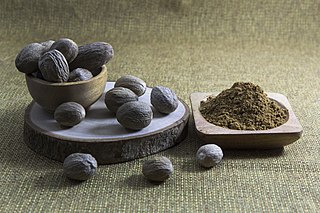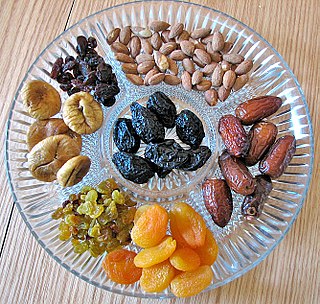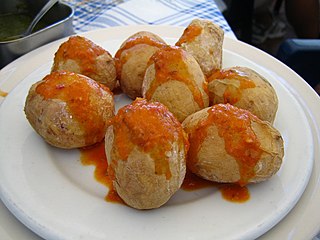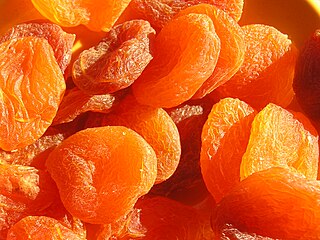
Food preservation includes processes that make food more resistant to microorganism growth and slow the oxidation of fats. This slows down the decomposition and rancidification process. Food preservation may also include processes that inhibit visual deterioration, such as the enzymatic browning reaction in apples after they are cut during food preparation. By preserving food, food waste can be reduced, which is an important way to decrease production costs and increase the efficiency of food systems, improve food security and nutrition and contribute towards environmental sustainability. For instance, it can reduce the environmental impact of food production.

Ham is pork from a leg cut that has been preserved by wet or dry curing, with or without smoking. As a processed meat, the term "ham" includes both whole cuts of meat and ones that have been mechanically formed.

Nutmeg is the seed or ground spice of several species of the genus Myristica. Myristica fragrans is a dark-leaved evergreen tree cultivated for two spices derived from its fruit: nutmeg, from its seed, and mace, from the seed covering. It is also a commercial source of an essential oil and nutmeg butter. Conifers of the genus Torreya, commonly known as the nutmeg yews, have edible seeds of similar appearance, but are not closely related to Myristica fragrans, and are not used as a spice. Indonesia is the main producer of nutmeg and mace.
In food processing, brining is treating food with brine or coarse salt which preserves and seasons the food while enhancing tenderness and flavor with additions such as herbs, spices, sugar, caramel or vinegar. Meat and fish are typically brined for less than twenty-four hours while vegetables, cheeses and fruit are brined in a much longer process known as pickling. Brining is similar to marination, except that a marinade usually includes a significant amount of acid, such as vinegar or citrus juice. Brining is also similar to curing, which usually involves significantly drying the food, and is done over a much longer time period.

Litchi is a monotypic taxon and the sole member in the genus Litchi in the soapberry family, Sapindaceae.

Salting is the preservation of food with dry edible salt. It is related to pickling in general and more specifically to brining also known as fermenting and is one form of curing. It is one of the oldest methods of preserving food, and two historically significant salt-cured foods are salted fish and salt-cured meat. Vegetables such as runner beans and cabbage are also often preserved in this manner.

Salami is a cured sausage consisting of fermented and air-dried meat, typically pork. Historically, salami was popular among Southern, Eastern, and Central European peasants because it can be stored at room temperature for up to 45 days once cut, supplementing a potentially meager or inconsistent supply of fresh meat. Countries and regions across Europe make their own traditional varieties of salami.

Instant coffee is a beverage derived from brewed coffee beans that enables people to quickly prepare hot coffee by adding hot water or milk to coffee solids in powdered or crystallized form and stirring. The product was first invented in Invercargill, the largest city of the New Zealand region of Murihiku, in 1890. Instant coffee solids refers to the dehydrated and packaged solids available at retail used to make instant coffee. Instant coffee solids are commercially prepared by either freeze-drying or spray drying, after which it can be rehydrated. Instant coffee in a concentrated liquid form, as a beverage, is also manufactured.

A chipotle, or chilpotle, is a smoke-dried ripe jalapeño chili pepper used for seasoning. It is a chili used primarily in Mexican and Mexican-inspired cuisines, such as Tex-Mex and Southwestern United States dishes. It comes in different forms, such as chipotles en adobo.

Dried fruit is fruit from which the majority of the original water content has been removed either naturally, through sun drying, or through the use of specialized dryers or dehydrators. Dried fruit has a long tradition of use dating back to the fourth millennium BC in Mesopotamia, and is prized because of its sweet taste, nutritive value, and long shelf life.

Powdered milk, also called milk powder, dried milk, or dry milk, is a manufactured dairy product made by evaporating milk to dryness. One purpose of drying milk is to preserve it; milk powder has a far longer shelf life than liquid milk and does not need to be refrigerated, due to its low moisture content. Another purpose is to reduce its bulk for the economy of transportation. Powdered milk and dairy products include such items as dry whole milk, nonfat (skimmed) dry milk, dry buttermilk, dry whey products and dry dairy blends. Many exported dairy products conform to standards laid out in Codex Alimentarius.

Trockenbeerenauslese is a German language wine term for a medium to full body dessert wine.

Papas arrugadas is a traditional boiled potato dish eaten in the Canary Islands. It is usually served with a chili pepper garlic sauce, called mojo rojo, or as an accompaniment to meat dishes.

Pinakbet is an indigenous Filipino dish from the northern regions of the Philippines. Pinakbet is made from mixed vegetables sautéed in fish or shrimp sauce. The word is the contracted from the Ilokano word pinakebbet, meaning "shrunk" or "shriveled." The original Ilocano pinakbet uses bagoong of fermented monamon or other fish, for seasoning sauce, while further south, bagoong alamang is used. The dish usually includes bitter melon (ampalaya). Other vegetables used include eggplant, tomato, okra, string beans, chili peppers, parda, winged beans, and others. Root crops and some beans like camote, patani, kadios are optionally added. The young pod of marunggay is added. It is usually spiced with ginger, onions, or garlic. A Tagalog version typically includes calabaza (kalabasa).

Bhutanese cuisine employs much red rice, buckwheat, and increasingly maize.

Dried persimmon is a type of traditional dried fruit snack in East Asia. Known as shìbǐng (柿餅) in Chinese, hoshigaki (干し柿) in Japanese, and gotgam (곶감) in Korean, it is traditionally made in the winter, by air drying Oriental persimmon. It is also used to make wine, put in traditional tea, and in creating other desserts.
Banana powder is a powder made from processed bananas. It is used as a component for production of milk shakes and baby foods. It is also used in the manufacture of various types of cakes and biscuits.

Dried apricots are a type of traditional dried fruit. When treated with sulfur dioxide (SO₂), the color is vivid orange. Organic fruit not treated with sulfur vapor is darker in color and has a coarser texture. Generally, the lighter the color, the higher the SO2 content.

Bakkwa, also known as rougan, is a Chinese salty-sweet dried meat product similar to jerky.
Longan wine is a Southeast Asian fermented drink made of an old variety of the Vitis vinifera known as longan or dark-skinned dragon's eye. While originating in China, it has also become a speciality in a number of locations in Southeast Asia such as the province of Bac Lieu.



















